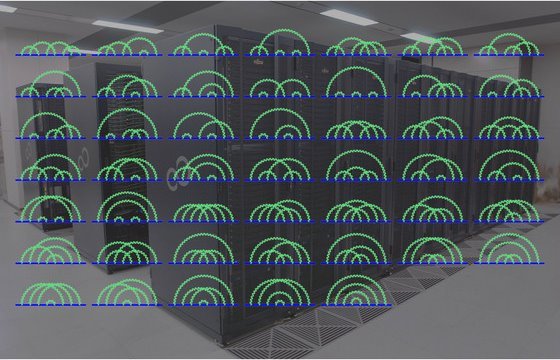Jan. 4, 2008 Research Highlight Physics / Astronomy
Electron’s magnetism pinned down precisely
Development of a computation system that can accurately predict electron magnetism provides a test of quantum theory
 Figure 1: Feynman diagrams that depict virtual emission and absorption of photons (green lines) from/to electrons (blue lines). The numerical calculations of these processes are carried out using RIKEN’s supercomputer system.
Figure 1: Feynman diagrams that depict virtual emission and absorption of photons (green lines) from/to electrons (blue lines). The numerical calculations of these processes are carried out using RIKEN’s supercomputer system.
The most precise theoretical calculation of the electron’s magnetism to date has been made by RIKEN scientists, providing them with a powerful test of quantum theory.
The electron’s magnetic strength is represented by its ‘g-factor’, which theoretical physicist Paul Dirac—who developed the mathematical foundations of quantum theory in the 1920s—valued at precisely 2.
But experiments have shown that the real value of g is slightly larger. This so-called magnetic moment anomaly is caused by quantum phenomena not included in Dirac’s original theory. In an attempt to pin down exactly why the difference arises, physicists improved theoretical predictions that agreed precisely with experimental results—and the g-factor has consequently become one of the most studied quantities in physics both theoretically and experimentally.
Tatsumi Aoyama and colleagues of RIKEN’s Nishina Center, Wako, have now developed a computation system that can predict g with an accuracy exceeding that of the latest experimental results1.
Much of the discrepancy in g is caused by the electron’s virtual emission and absorption of photons—a process where the electron behaves as if fleeting packets of light are bouncing between it and its surroundings. This process is described by the theory of quantum electrodynamics (QED).
The RIKEN team has established the effects of four virtual photons around the electron, known as the eighth-order contribution. The photons’ effects can be depicted by Feynman diagrams. The researchers’ automated computation system has calculated 518 of 891 Feynman diagrams involved in the eighth-order term of the g-factor (Fig. 1), refining the number to astonishing levels of precision. The other 373 diagrams were obtained previously.
A more precise g-factor allows scientists to determine a more accurate value of the fine structure constant, α. This fundamental constant of nature characterizes the strength of the electromagnetic force that governs the interaction between light and matter. Determining α provides a stringent test of QED, and also has strong impact on determining units of electric charge, mass, electric resistance, and many others.
The RIKEN team is now working to calculate the tenth-order contribution to the g-factor anomaly. “The measurement uncertainty has been reduced to less than one in a trillion, so we are now at the stage where a reliable estimate of the tenth-order contribution is needed,” says Aoyama.
The tenth-order term involves 12,672 diagrams, he adds, estimating that the new computer program for integrating these diagrams will need about one hundred million lines of FORTRAN source code.
References
- 1. Aoyama, T., Hayakawa, M., Kinoshita, T. & Nio, M. Revised value of the eighth-order contribution to the electron g – 2. Physical Review Letters 99, 110406 (2007). doi: 10.1103/PhysRevLett.99.110406
